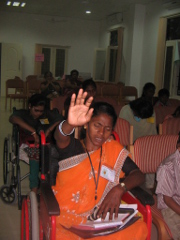Iran (MNN) — Yesterday, Southeast Iran was hit by the most powerful earthquake to strike the country in 40 years.
The quake, measuring 7.8-magnitude, was felt as far away as New Dehli, according to reports from the U.S. Geological Survey. While the preliminary death toll stood in the mid-40s, it could have been a lot worse. Greg Garrett, a SAT-7 spokesman, explains, "Both earthquakes occurred in fairly rural areas without a large population base. However, there has been loss of life in both cases. The first one being about 50 people; the one today, the last report I heard said about 40 people."
Tuesday's temblor, coupled with the 6.1 quake reported last week in Bushehr Province, raised the ghosts of 2003 for many: a 6.6-magnitude earthquake near the city of Bam killed at least 26,000 people.
The state-run news agency noted that a state of emergency was declared in the hardest-hit area, and rescue workers were on their way from other provinces. Communications are down in many places, so assessment teams are just beginning to survey the damages. One thing they already know: "They're very poor areas with very limited medical supplies and fairly limited resources to help them, so it's a fairly desperate situation for the families in those areas."
SAT-7 PARS came into being in 2006, so regular viewers already know where to go when they need some hope. Garrett says, "Our main goal is to provide spiritual support helping people understand that God is there for them, that God is helping them. We are certainly soliciting prayer support, we are doing numerous campaigns on our live shows."
The production team has already provided a community platform for people to respond. One live program aired Tuesday night. Another airs Wednesday, and a third live program is slated for Saturday.
Why so many? Garret explains it's a live show, and the format allows them to respond quickly in times of crisis. "We do have live interaction with people who are from Iran that call in. We offer prayers, and we offer support. it's really amazing how a television station provides that kind of spiritual prayer support that I think is very needed in times like this."
There are an estimated 160 Farsi language satellite television channels available in Iran, but only 3 are Christian channels, including SAT-7 PARS which broadcasts 24/7. That means they have a specific function for that niche. "We're also running two three-minute spots, roughly five times a day, right now offering prayers. We have different SAT-7 staff and partners of SAT-7 who are coming in and offering prayers and offering their support online via our Web site, via our social media."
Their focus, says Garrett, is not on the crisis itself. "We're really trying to emphasize the fact that at times like this, it's ultimately God who brings the comfort that is needed, but we're seeing family rise up and helping family."
Please keep praying for more opportunities to open the door for the hope of Christ. Garrett adds,"The main prayer that we're continually asking is that the God of Peace would come and comfort those who mourn. That, we feel, is very critical in this hour." Pray for the workers who will be the Gospel in this region. Pray for the needed funding.
*PARS is the Farsi language word for "Persian." It references Persian history and culture in a way that unites Iranian people today and reminds them of a time before the current domination by religion and regime.

